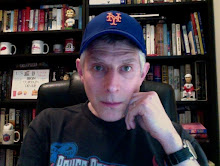She's right. I am. Guilty as charged. Wearing a blue Chicago Cubs t-shirt on the day after they'd won their first National League pennant since 1945, what right have I -- a life-long Mets fan -- to cheer for a team I avoided supporting for almost a decade while living just blocks from Wrigley Field?
 |
| Last place Mets beat the 5th place Cubs, 2-0. |
Bandwagon jumper. Hypocrite. Front-runner. Fraud. "You're honor, the defendant would like to enter a plea of `Nolo contendre.'" Still, I can't help but cheer for the team I expressly rejected in favor of their less-popular intra-city rivals, the White Sox, while there.
My meager, pathetic justification is this:
I was born in an NL New York household, a son of Brooklynites abandoned by the Dodgers and morally unwilling and unable to embrace the Yankees, an act my father said was tantamount to cheering for the First National City Bank.
So, it was root for the Mets and whoever was against the Yankees, a pretty easy edict, even after I left home in 1983 for college in Boston, where the enemy of my enemy was the Red Sox. That all changed of course in 1986, when the formerly-down-trodden Mets -- who were a last place team in '83, 82, 79, 78 and 77 -- collided with the still-hexed Sox in the 1986 World Series.
There comes a time in every fan's life where his loyalty is tested, where the ties that bind one, heart and soul, to the old home team are strained by circumstance, by peer pressure, by the urge to try a new relationship. And so it was that I had blended with Red Sox nation. I wore the clothes, I bought $3 bleacher seats. I munched Sports Bars, drank beer and imbibed the lore... about the heartaches wrought by Series losses in '46 and '67 and '75, Pesky's hesitation, Gibson's dominance, Armbrister's interference. I already knew about the karmic wound inflicted by Bucky "Bleeping" Dent.
 |
| Dykstra led off with a homer. The Mets never trailed. |
And so it would be, 20 years later, when I found myself moving to Chicago while the White Sox were the champs and the Mets seemed to be a rising NL East power.
Why adopt the Cubs? Why absorb their lore: the Billy Goat curse, Leon Durham's error, the Steve Bartman incident? Why should I -- by then a long-suffering Mets, Jets and Islanders fan -- take on their burden when I had better options? Besides, rooting for another NL team was a conflict of interest (a rule I still observe to this day).
Cynical, middle-aged me.
For a time, it worked, especially for one golden inning on an ungodly hot Summer Sunday at Wrigley Field when the Mets pummeled a succession of Cubs pitchers for 11 runs, including three homers, two of which were grand slams.
The rising power Mets were soon humiliated by an Adam Wainwright curveball in the Autumn of '06, then bedeviled by late-season collapses in '07 and '08, failures that coincided with back-to-back NL Central titles for the Cubs and another playoff appearance for the White Sox.
 |
| Struggling Mets 7, Struggling Cubs 4 |
Truth is I had a sneaking admiration for the Cubs' aesthetic, the classic uniforms, the bullseye logo largely unchanged since I was a kid, the ballpark, the neighborhood, the absurdly optimistic fight song sung there with conviction. "Go Cubs! Go!"
Chicagoans care passionately about their city. It may seem to those who don't live there that it's one big free-fire zone, but it's not, and everyone wants it to be a better place. The people who live there have a civic pride the likes of which I've never known. The Cubs evoke an even deeper passion. Despite 108 years of failure, their fans endure. Their enthusiasm never wanes. Even with ample justification. Their hope never dies. They've suffered and suffered and suffered some more.
They've paid their dues in spades.
Meanwhile the Mets are done until next Spring. Unlike last season, there are no operable conflicts of interest. With all due respect to fans of the Cleveland Indians -- waiting since 1948 for a World Series winner to call their own -- the Cubs and their fans have waited 40 years more. I want this for them.
Go Cubs, Go!
-- Follow me on Twitter @paperboyarchive











